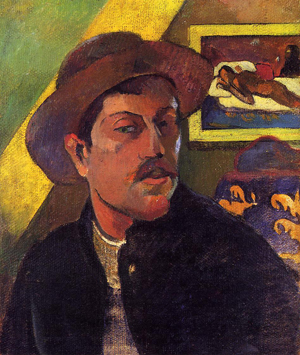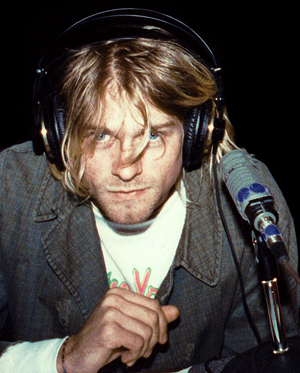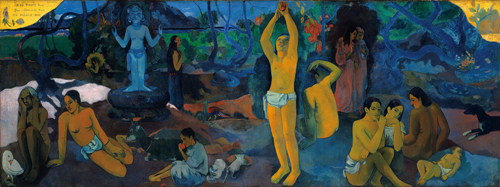
Your complimentary articles
You’ve read one of your four complimentary articles for this month.
You can read four articles free per month. To have complete access to the thousands of philosophy articles on this site, please
Art & Philosophy
Art & Morality: A Bittersweet Symphony
Jessica Logue conducts an investigation into their relationship.
For a number of years I have been interested in the question, ‘Does a life’s work make up for a life?’ Initially, what I had in mind is the idea that there’s a line between one’s public and personal life, that those two lives can be separated, and that somehow you could weigh them against one another, as though professional success might make up for various personal, in particular, ethical, failures. So for instance, could the artistic achievements of a talented painter or writer make up for their being a terrible spouse?
It has struck me as an important but difficult question to answer. Although it’s true that everyone makes poor choices, when those poor choices are made by public figures, gauging the appropriate response on the part of an admiring public seems useful. While some may take the stance that it’s easy to separate ethical choices from the rest of a person’s life, and therefore still support their projects or successes although they’re a bad person, I am not so certain. For the sake of narrowing the playing field, I am going to discuss examples that have to do with art and entertainment, although there are plenty in other areas as well.
In his book Moral Luck (1981), the philosopher Bernard Williams raised issues of this kind in his discussion of the artist Paul Gauguin (1848-1903). Gauguin abandoned his wife and children to go to paint in Tahiti. Williams framed the issue in terms of the titular ‘moral luck’ – the notion that sometimes ethical outcomes are due to factors beyond our control. And to an extent Williams is right about Gauguin’s moral luck: had he not succeeded in making renowned art, we might judge his life choices more harshly – if we remembered him at all.
However, in light of the #metoo movement especially, I find my question pressing, and I do not think that at its heart the issue is one of moral luck. There are too many examples of bad behavior, even only from the world of art. For example, when I first became interested in this issue, I was disappointed to learn that Dr Seuss’ extramarital affair may have led to the suicide of his first wife. Reading about Charles Dickens and discovering what a horrible husband and father he was also disappointed me. Byron’s incest; Picasso’s abhorrent treatment of the women in his life; the dreary list goes on and on. A shocking number of bad people have made renowned art, and it’s not a phenomenon that appears to be going away. So for a number of years I have been considering how to respond to this revelation.

Paul Gauguin Self-portrait with Hat, 1893
Originally, the stance I took was utilitarian: if the life of the individual artist taken as a whole seems likely to have increased the overall sum of human happiness (or pleasure, perhaps), then perhaps we could overlook certain personal choices. This idea does seem to work in some cases. Perhaps it works in the case of Dr Seuss (real name Theodor Seuss Geisel). Maybe the literary contributions of Dr Seuss outweigh his personal choices.
Yet, over time, this utilitarian approach did not sit well with me. First of all, how can we even measure whether or not a person’s choices, personally and professionally, do promote the greatest good? There does not seem to be an objective way to assess choices and their impact. Even if there were, it seems callous and ignorant to ignore the harm that (say) Seuss’s choices may have done his wife. Therefore even if there were some way to prove that his actions really did promote the greatest good for the world’s population as a whole, it seems such calculations may lead to us excusing unethical behavior towards individual people.
Rethinking this question, I realized there are probably easier ways of dealing with it, and that instead virtue ethics may yield a better result, or at least, a result that sits better with me. And this is perhaps where I have found my answer to this question.
Virtue ethics is founded on the cultivation of virtues, in the hope of this producing virtuous thinking and behavior. One practices being patient, for example, in the hope that this will lead to the development of a patient character. Virtue ethics often involves a ‘moral exemplar’, which is a fancy term for a role model. Moral exemplars are important because they show us what ethical behavior looks like.
This also allows us to ethically disassociate from the personal choices of great artists. For instance, it allows us to sidestep the issue of morality by saying that most artists simply don’t set out to be moral exemplars and shouldn’t be judged as such. Perhaps this stance will allow me to still read the novels of Norman Mailer, even though he almost killed his wife.
But this answer might not be enough. Perhaps the problem of my opening question persists. After all, in the end, it’s not the morality of artists that we admire. We admire them for their talent. However, in admiring their talent, I’m still not so sure we should turn a blind eye on their misdeeds. Our own actions as purchasers of art many have consequences too, as enablers of artists behaving badly. Perhaps then we should still be wary of supporting the careers of unethical artists, both financially and in terms of boosting their fame. Maybe we shouldn’t be lining the pockets of artists who commit domestic abuse or who perpetrate hate speech, or who have committed heinous crimes. There’s a growing number of people in the media, entertainment industry, and politics I have chosen to simply ignore in light of them being accused of sexual misconduct. I have drawn my own moral line, and that line involves turning my back on them and keeping my payment card away from them. But this line is definitely fuzzy, and subjective. While I have turned my back on Bill Cosby, others have not.
Role Model Suicide

Kurt Cobain, 1991
Cobain photo © Julie Kramer 1991
Keeping these complexities in mind, I want to turn to a different sort of case: suicide, taking as my example the suicide in 1994 of Kurt Cobain, musician, songwriter, and frontman of the band Nirvana.
Cobain’s suicide occurred when I was in high school. This was not only my first memorable experience of the suicide of a public figure, but it was the suicide of someone of whom I was a devoted fan. To me, Nirvana were the voice of my generation. They were the revolutionaries who saved music from the hairspray era of the 80s. Cobain sang about things that mattered to me. His music was artistic and complicated and loud. I loved his counter-cultural attitude, his gender-bending wardrobe choices and his covering of songs by obscure bands. And I loved that he offered up an alternative to the stifling suburban values, hypocrisy and materialism of the community in which I grew up. I still love his music more than twenty years later.
But Cobain killed himself, leaving his daughter to grow up without a father. I cannot even contemplate the difficulties she must have faced growing up in that aftermath (and I lost a parent just after my first birthday). How Frances Bean Cobain made sense of her grief and abandonment with news headlines and public anniversaries ever-present is beyond my imagination; but I can understand why in a Rolling Stone interview she claimed she preferred the music of Oasis to Nirvana. It can’t be easy to have grown up being told your self-deceased father was the voice of a generation.
My husband and I used to talk about Cobain frequently. After all, we lost the greatest musician of our generation, an iconoclast; and someone with so much musical potential yet untapped. In the midst of our musings we realised that many of the rock stars whose music we had enjoyed in the 90s were now dead, either by suicide or from drug overdoses. Then we wondered, what should our response be to Cobain’s suicide, or the suicides of other great artists we love, from a moral perspective? Should we condemn them for the pain they caused to the families and friends they left behind?
This area is arguably morally much more complex, due to the mental health issues involved. Certainly there is a global mental health crisis, and we’re still in the infancy of understanding how to help those who struggle – especially those in the public eye. We have not yet come to understand how to throw a lifeline to those in the limelight. Nor do we seem to have generated appropriate responses in the face of these tragic events. Rather, we want to promote both the fame and the loss, without examining their relationship with one another – without seeing the death as being related to the fame. We cannot use our own grief to pretend we understand. Neither should we employ our grief in such a way that further glorifies fame, overlooking the problems of those who struggle in its jaws.
This returns me to the suggestion I made about turning our wallets away from those we can’t ethically support. But again, with cases of suicide, the issue becomes additionally complex. The glorification of the dead is a very sensitive issue here, and how we represent their lives and deaths must be handled with great care. At what point does the position of being a fan require more from us, morally speaking? Moreover, how do these questions compare with the questions provoked for fans by the failings of artists who are still alive and working? Someone might wonder: why am I willing to listen to Nirvana, but not to watch one of Woody Allen’s films? Or, why am I disgusted by Picasso, but admire Cobain’s willingness to question whether or not he was selling out?
Clearly I would not be a fan of Cobain if he had been a rapist or pedophile; I would not be able to stomach listening to his music. This has led to me to conclude that I morally object more to rape, murder, and pedophilia than I do to suicide. I think it’s fair to see Cobain’s act as largely motivated by pain and isolation. Suicide is often a result of mental illness, so even though the psychological and emotional effects on loved-ones might be just as devastating as those from other immoral actions, we ought not to be think of it on the same level of moral awfulness as abuse and other evils.
This reflection has in turn caused me to return to the #metoo movement and reconsider how I have abandoned watching Woody Allen’s films, amongst others. Perhaps any apparent inconsistency on my part is partly due to a distinction between the living and the dead. Allen is living, and can face public condemnation for his actions, whereas Cobain cannot. It’s also easier to forgive someone a transgression when it’s seen set against a painstricken landscape. It is much harder to forgive those who appear unapologetic for their personal choices – and so many of those exposed by the #metoo movement do not seem remorseful for what they have done.

More Gauguin: Where Do We Come From? What Are We? Where Are We Going?, 1898
Tentative Conclusions
I now find trying to weigh artists’ professional choices against their personal ones to be ethically misleading.
This shows an additional strength of virtue ethics. When a student who had been caught plagiarizing cried in my office, “Everyone will think I’m a cheater for the rest of my life!”, I assured him that one action does not define a life. I was thinking of virtue ethics at the time. We don’t always live up to our own virtuous ideals. That’s part of the human condition; and thus the weighing and measuring of choices against one another is a naive calculation and a potential source of misunderstanding of the goodness of a life.
I am not saying that our choices are atomistic and can easily be discounted, nor that there is no way of looking at (and perhaps assessing) the whole. What I am saying is that there is no ledger, no ethical version of Santa’s naughty and nice list, and that any attempt to make one may be hopelessly misleading. For instance, such a list might ignore a person’s ethical growth. Or it might make more of or less of the impacts certain behaviors and choices have. In some cases such a list might also be a false attempt to wipe the slate clean of a certain blemish. That ideal itself is naive. Although one instance of cheating should not define the whole of that student’s life, it also should not be removed from his record. Certainly, that isolated bad choice is something he can overcome: but to pretend that we can erase it from his history is, among other things, to ignore the positive changes he may have made.
So, does a life’s work make up for a life? The answer is not a simple yes or no. Infidelity, incest, racism, sexism, sexual assault, abandonment, and so on, matter. They are immoral actions, and great art does not make up for the fact that they happened. There are people who suffered because of those actions. Liking the art made by those who have committed these actions doesn’t erase the victims or the deeds.
So does it matter what the artist did or did not do? Their moral failings? Yes! These things do matter, morally speaking. While I think it is possible to appreciate art made by moral scumbags, that’s only because art and ethics are not the same thing. And because they are not the same thing, they cannot be measured in the same way. But I think we do a great disservice by elevating artists to heroic status when their lives are so unheroic. Their transgressions do matter in a moral context, and so supporting the art of people you find morally reprehensible is difficult to justify, especially when money enters the equation. We should be wary of what we adore, and unafraid to ask ourselves if fame itself is worthy of our worship.
© Dr Jessica Logue 2021
Jessica Logue is a lecturer in Philosophy at the University of Portland, Oregon.








